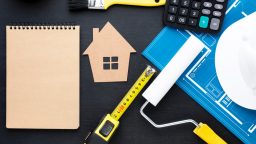The exterior of your home is the first thing people see, and it plays a huge role in making a positive impression. However, maintaining the outside of your house is more than just about curb appeal—it’s also about protecting your home from the elements, preventing costly repairs, and ensuring that everything from your roof to your garden stays in good condition. Regular upkeep is essential to ensure the longevity of your home and its value. Here are some important tips and tasks to help you maintain your home’s exterior year-round.
- Inspect Your Roof Regularly
Your roof is one of the most important parts of your home’s exterior, as it protects everything underneath it. Over time, your roof can become worn or damaged by harsh weather, falling debris, or general wear and tear. It’s crucial to inspect your roof regularly to spot any signs of damage before they become bigger issues.
Look for cracked, curled, or missing shingles, and check for any dark spots or water stains on the ceiling inside your home, which could indicate leaks. If you spot any damage, it’s best to call a professional roofer to assess the situation. Regular roof maintenance, such as cleaning out gutters and checking for debris, can extend the life of your roof and prevent water damage.
- Clean and Maintain Your Gutters
Gutters play a critical role in protecting your home from water damage by directing rainwater away from your roof and foundation. However, clogged gutters can cause water to overflow, leading to leaks, roof damage, or even flooding in your basement. It’s essential to clean your gutters at least twice a year—once in the spring and again in the fall—when leaves and debris are most likely to accumulate.
When cleaning your gutters, remove any leaves, twigs, and dirt, and check for any signs of rust, holes, or cracks. If you have trees near your house, consider installing gutter guards to reduce the amount of debris that collects in the gutters. Regularly cleaning and maintaining your gutters can prevent water damage and keep your home in good condition.
- Paint and Seal Your Exterior Walls
The exterior paint of your home is not just for aesthetics—it also serves as a protective layer against the elements. Over time, exposure to sun, rain, and wind can cause paint to fade, peel, or crack, leaving your home vulnerable to moisture and weather damage. Repainting your home’s exterior every 5-7 years can protect the materials underneath and maintain a fresh look.
Before repainting, check for areas where the paint is chipped, cracked, or peeling, and sand those areas down. In some cases, you may need to apply a primer before repainting to ensure the new paint adheres properly. You should also inspect caulking around windows and doors to ensure a tight seal and prevent drafts or water infiltration.
- Clean and Repair Your Windows
Windows are not only an essential feature of your home’s exterior but also a major part of your home’s energy efficiency. Over time, dirt and grime can accumulate on your windows, reducing visibility and making your home look neglected. Regular cleaning, both inside and outside, can help maintain the clarity of your windows.
Check the seals and frames of your windows for any signs of damage, such as cracks, warping, or mold growth. If your windows are old or drafty, it might be time to replace them with energy-efficient models to improve insulation and reduce your energy bills. If you notice condensation between double-paned windows, this could indicate a broken seal that may need repair.
- Maintain Your Siding
The siding of your home not only contributes to its appearance but also protects it from the elements. Whether you have wood, vinyl, brick, or another material, it’s essential to inspect and maintain your siding regularly. Wood siding can be prone to rot, insect damage, and fading, while vinyl siding can become cracked or discolored over time.
Clean your siding at least once a year with a pressure washer or a hose and cleaning solution to remove dirt, mold, and mildew. For wood siding, check for any signs of rot or pest infestations and treat or replace damaged sections as needed. For vinyl or brick siding, check for cracks or gaps where water could seep in, and seal them with caulk to prevent damage.
- Check and Maintain Your Lawn and Landscaping
A well-maintained lawn and landscaping can significantly improve your home’s curb appeal, but it also requires regular upkeep. Mow your lawn regularly to keep it neat, and water it consistently during dry periods. Aerating your lawn every few years can improve soil health and promote healthy grass growth.
Pay attention to your plants, shrubs, and trees, ensuring they’re properly pruned and free from disease or pests. Remove any dead or overgrown plants and replace them with new ones if necessary. Keep an eye on tree branches that could potentially cause damage to your home, especially after storms or heavy winds.
- Maintain Your Driveway and Walkways
Your driveway and walkways not only need to be functional but also safe and attractive. Over time, cracks, stains, or wear can develop in these areas, which can not only look unsightly but also create tripping hazards. Regularly inspect your driveway and walkways for cracks or damage, and repair them promptly to prevent further deterioration.
For concrete driveways, use a concrete cleaner and reseal it every couple of years to maintain its appearance and durability. For asphalt driveways, look for cracks and fill them in with asphalt patching compound to prevent water from seeping in and causing further damage. Pressure wash your walkways to remove stains and debris, and consider resealing stone or paver walkways if they show signs of wear.
- Check Your Outdoor Lighting
Outdoor lighting plays a significant role in the safety and ambiance of your home’s exterior. It’s important to check your outdoor lighting fixtures regularly to ensure they’re functioning correctly and providing adequate illumination. Replace any burned-out bulbs and clean the fixtures to remove dirt and debris that may block light.
Make sure all outdoor lighting is working properly and illuminating the areas where it’s most needed, such as the front door, driveway, and walkways. If you have motion-sensor lights, check that they are properly aligned and activated. Installing energy-efficient LED lights can help reduce your energy usage while still providing ample lighting.
- Check for Pest Problems
Your home’s exterior can be vulnerable to pests like termites, ants, rodents, or other critters that can cause significant damage if left unchecked. Regularly inspect your home for signs of pest activity, such as holes in the foundation, termite mud tubes, or nests in the attic.
Seal any cracks, gaps, or holes in the exterior of your home to prevent pests from getting in. Make sure that vents and chimneys are properly sealed, and that gutters and downspouts are clear to avoid attracting pests. If you suspect a major pest problem, call a professional pest control service to deal with the issue.
- Regularly Clean and Inspect Your Fence
Fences not only provide privacy but also contribute to your home’s overall curb appeal. Over time, weather and wear can cause your fence to deteriorate. Whether you have a wooden, vinyl, or metal fence, regular cleaning and maintenance are essential.
Check for loose or broken panels, nails, or posts and repair them promptly. If you have a wooden fence, consider staining or sealing it every few years to prevent rot and weather damage. For vinyl or metal fences, pressure washing can remove dirt, stains, and algae that can accumulate over time.
Conclusion
Maintaining your home’s exterior requires regular attention, but with proper care, it can extend the lifespan of your home, enhance its curb appeal, and ensure that it remains a safe and comfortable place to live. By inspecting and maintaining your roof, gutters, siding, windows, landscaping, and other exterior features, you can prevent costly repairs down the road and keep your home looking its best year-round. Regular upkeep will also add value to your property, making it a sound investment for the future.





